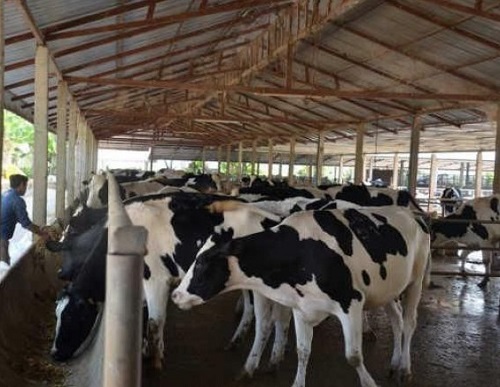Lao Dairy Farm Carves Out Healthy Market Niche
Source: The Nation
WITH agriculture in Laos improving year by year, a new farm in Vientiane called the Lao Dairy Farm is carving out a sizeable share of the fresh milk market. Its main selling point is that the quality of its pasteurised milk is as good as imported brands.
The farm is located in Naxineua village, Naxaithong district. It keeps a variety of animals, including goats, pigs, ducks, chicken, and fish, but its mainstay is its herd of dairy cows.
Farm Director Sengmany Yathotou told Vientiane Times last week that they began in 2014 with 16 cows which they kept for the family’s use and tended to after work because the family enjoyed agricultural activities.
To start with, they never thought about how much milk they obtained from the cows each day and didn’t think about selling it. They used it only for their own consumption, sometimes giving some to their neighbours, friends or relatives.
After a year, people in the neighbourhood and nearby shops started asking them to provide milk for sale because they had tried it and liked the taste.
They started to sell the milk in markets and shops in Vientiane such as M-Point Mart, and coffee and cake shops, and have since expanded their distribution from four to eight minimarts.
Their 16 original cows were bred in Australia but were imported from Thailand. The family now has 110 cows including some calves that were born on the farm.
Sengmany says the farm is equipped with modern technology that ensures all the milk is hygienically produced and the milk-based products are made on the premises.
The farm is now promoting its “Crysta” brand and hopes it will become widely recognised and be able to compete with overseas milk brands.
The cows are milked twice a day, with each giving 10 to 15 litres, making a daily total of about 450 litres.
Sengmany plans to expand her milk market in the provinces of Luang Prabang, Xieng Khuang and Attapeu, and is currently looking at transport costs.
“Keeping a dairy herd is still something new for us, especially getting the cows pregnant so that they produce calves. It’s very difficult as we’re not very familiar with this and run the risk of the newborn being a male rather than a female, and of course we would prefer females,” she says.
“The second challenge is that we have to get more people interested in eating and drinking food produced in Laos. But we’re sure that if they try our products they will find that the taste and quality is the same as international brands.”
The farm covers more than 10 hectares, including fields of Napier grass and sweetcorn for the cows to eat.
The family makes pasteurised milk, yogurt, and yogurt drinks.
The milk is popular with expatriates and is also used to make cheese, which is sold to shops.
The Lao Dairy Farm employs 40 people including two specialists from Thailand and Vietnam who studied milk production in Denmark.
“Some of our cows are pregnant and there are three or four births each month, so that means we will have more cows and we’re sure to get at least 700 litres of milk a day in the next three months and then we will expand our market to the provinces,” Sengmany says.
The cows’ pregnancy lasts for nine months after which they produce milk. The calves can become pregnant when they are one year old.
Some of her customers ask Sengmany why her products are not cheaper since they are made in Laos. But she explains that everything on the farm is new and imported, especially the medicines and vitamins that are given to the cows. They use high quality materials but she points out that their retail prices are no higher than anyone else’s.
The Lao Dairy Farm plans to open a cafe on the first floor of Lao-ITECC, which will feature milk and yogurt, as part of its market expansion plans.

